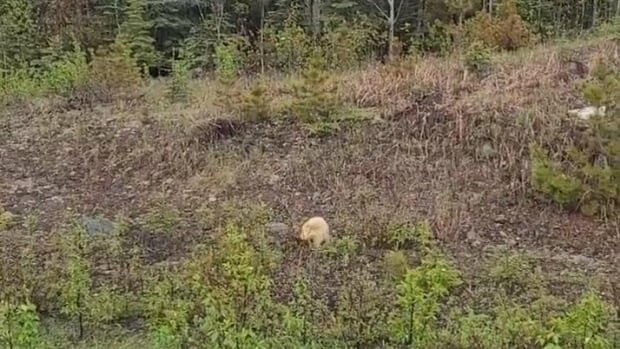Holly Palmer along with her boyfriend and dog, Shadow, were driving back home to Watson Lake, Yukon, when what they thought was a white rock on the side of the Alaska Highway started to move.
That’s when they pulled over by the Morley River, just before the bridge crossing, and Palmer started recording a video.
The “rock” waddled up the hill and into the woods.
What was it?
A cream-coloured porcupine, according to Palmer, who’s seen many porcupines this year, but they have all been brown or black.
“What are the odds — I’ve never even heard of an albino porcupine before,” she said.
WATCH | Albino porcupine is spotted on the Alaska Highway:
Palmer said she noticed the porcupine didn’t have bright, red eyes like she expected to see in an albino animal.
That’s because there can be gradations of albinism, says Tracy Marchant, a biology professor at the University of Saskatchewan.
Marchant says there can be albinism with the complete lack of pigment, which means an animal is white with red or pink eyes, or albinism where some pigment is produced and an animal could still have dark eyes.
The second type of albinism could explain why the porcupine Palmer saw was not snow-white but more cream-coloured and had dark eyes.
There is another condition called leucism, where the cells that produce melanin (or pigment) are not present. It can cause white patches.
Likely albino, not leucistic: professor
Marchant says she “wouldn’t bet the house on it” but is fairly certain the porcupine is albino, not leucistic.
“We’d really have to have the animal in hand to actually look at it in more detail as to what its coloration is,” said Marchant, who also urged to leave the porcupine alone.
She says the ultimate way of answering that question would be to do a DNA test.
Despite sticking out in its forest home and making it a target for predators, the blonde critter could still live a good life.
“I think it can be a good porcupine. They’ll go along and munch the trees and chew up the bark and hide away when it needs to,” said Marchant.
Plus it still has its number one defense — its quills.
As for Palmer and her boyfriend, they were very excited to experience something so unique.
“I just thought it was really special to see something so rare,” said Palmer.
Source link



Be First to Comment